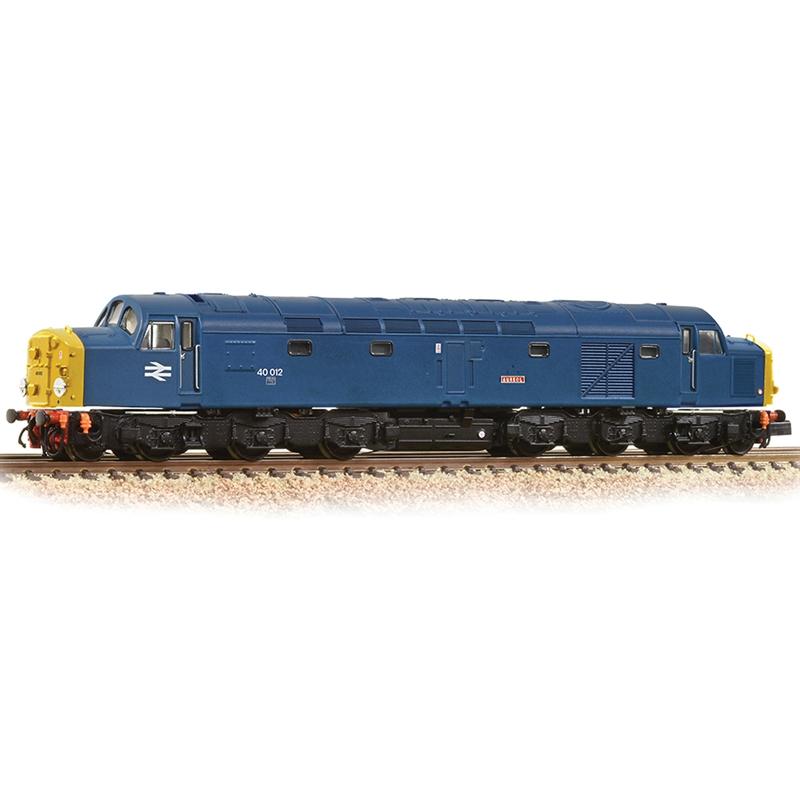GRAHAM FARISH N Class 40 Disc Headcode 40012 ‘Aureol’ BR Blue GRAHAM FARISH
$ 254,99 $ 102,00
GRAHAM FARISH Class 40 Disc Headcode 40012 Aureol BR Blue N SCALE.
We are pleased to expand our range of Graham Farish models with this workhorse Class 40 with Disc Headcode No. 40012 ‘Aureol’ in BR Blue livery. Featuring interior cab lighting and directional lighting, the model is also equipped with a Next18 DCC decoder socket and is pre-fitted with a speaker for those wishing to add DCC Sound.
MODEL FEATURES:
- Graham Farish N Scale
- Era 7
- Pristine BR Blue Livery
- Named Aureol
- Disc Headcode
- Next18 DCC Decoder Socket
- Recommended for use with Decoder 36-567
- Speaker Fitted
- NEM Coupling Pockets
- Interior Cab Lighting
- Directional Lighting
- Accessory Pack
- Length 153mm (over couplings)
History
The British Rail Class 40 is a British Railways diesel-electric locomotive, rated at 2,000 hp and classified as a Type 4. A total of 200 were built by English Electric between 1958 and 1962 and numbered in the series D200-D399. They were for a time the pride of the British Rail early diesel fleet. Despite their initial success, by the time the last examples were entering service they were already being replaced on some top-link duties by more powerful locomotives. As they were slowly relegated from express passenger uses, the type found work on secondary passenger and freight services where they worked for many years. The final locomotives ended regular service in 1985.
Class 40s operated in all areas of British Railways although Western and Southern Region workings were less common. After the early trials, the majority of Class 40s were based at depots in northern England; notably Longsight, Carlisle Kingmoor, and Wigan Springs Branch on the Midland Region, and Thornaby and Gateshead on the Eastern Region.
The heyday of the Class was in the early 1960s when they hauled top-link expresses on the West Coast Main Line and in East Anglia. However, the arrival of more powerful diesel locomotives, such as Class 47s and Class 55s, together with the electrification of the West Coast Main Line, meant that the fleet was gradually relegated to more mundane duties. In later life, the locomotives were mainly to be found hauling heavy freight and passenger trains in the north of England and Scotland. As additional new rolling stock was introduced, their passenger work decreased, partly due to their lack of electric train heating (D255 was fitted with electric train heating for a trial period in the mid-1960s) for newer passenger coaches. They lost their last front-line passenger duties – in Scotland – in 1980, and the last regular use on passenger trains was on the North Wales Coast Line between Holyhead, Crewe and Manchester, along with regular forays across the Pennines on Liverpool to York and Newcastle services.
Throughout the early 1980s Class 40s were common performers on relief, day excursion (adex) and holidaymaker services along with deputisation duties for electric traction, especially on Sundays between Manchester and Birmingham. This resulted in visits to many distant parts of the network. It would be fair to say that few routes in the London Midland and Eastern regions did not see Class 40-worked passenger services from time to time. Regular destinations included the seaside resorts of Scarborough, Skegness and Cleethorpes on the Eastern region, with Blackpool and Stranraer being regularly visited on the West Coast.
| Title | Default |
|---|
Quick Shipping and Professional Packaging
Due to our long-term partnership in a long-standing partnership with UPS, FedEx, DHL and many other leading global carriers, we are able to offer an array of shipping options. Our warehouse staff are highly trained and will pack your products according to our precise and precise specifications. Your items will undergo a thorough inspection and be securely secured prior to being delivered. We ship to thousands clients each day across multiple countries. This is an indication of our dedication to being the biggest online retailer in the world. The warehouses are located in Europe as much as they are in the USA.
Note: Orders that include more than one item are assigned a processing time in accordance with the item.
Prior to shipment before shipping, we'll inspect thoroughly the items you've ordered. The majority of orders are shipped within 48 hrs. The time to deliver varies from 3-7 days.
Returns
We don't manage the stock in our warehouse and factory. Stocks are subject to change at any moment. You may not receive your order after the order has been made.
Our policy is for 30 days. If you have passed 30 days by since your purchase, unfortunately we can't offer you a refund or exchange.
The item cannot be used and in its original condition. It should also be in the original packaging.
Related products
RADIO CONTROL
RADIO CONTROL
RADIO CONTROL
RADIO CONTROL
RADIO CONTROL
RADIO CONTROL
RADIO CONTROL
RADIO CONTROL
RADIO CONTROL
RADIO CONTROL
RADIO CONTROL
RADIO CONTROL
RADIO CONTROL
RADIO CONTROL


































